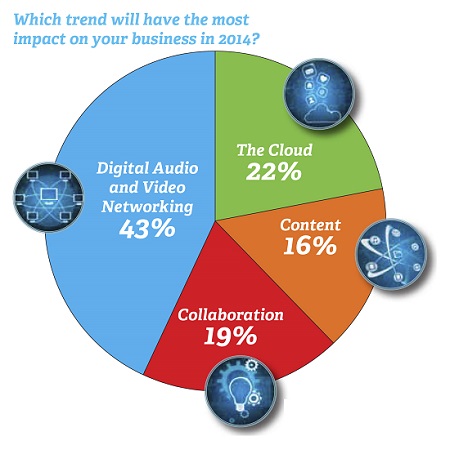No Delorean Required

Predicting what the next year will bring for AV integration
>>> SCN Online Survey
An industry friend of mine earlier this year proclaimed, “It’s much more fun being an AV integrator now,” and I think he has the right attitude. Turmoil can provoke fear or it can prompt an invigorating sense of imminent change. It all depends on your perspective, and you can choose the adrenaline charge option by seeking the business opportunities that lie on the flipside of tumult. Shrinking hardware margins can trigger a bolder approach to selling service contracts. AV and IT convergence might reveal partnership opportunities that land you in the middle of larger projects. And with Moore’s Law dictating the pace of change, at least your work is never boring, right?
For our year-end issue, I asked AV consultants and integrators about the fun that they expect to enjoy at work next year, and the responses were definitely exciting. Much change is afoot, and that can make a bunch of tech-heads giddy with anticipation.
The following are predictions for 2014 on a number of technology topics that will affect business now and in the future. You’ll find consensus among many business leaders on the direction we’re heading, and where there are divergent perspectives may lay new frontiers.
Beyond these broad topics, our panel of experts also shared other expectations for industry evolution. The cloud is already affecting design and project management through collaborative offerings such as Bluebeam and Google Drive, and the overall trend of virtualization will change infrastructure forever. Mobile devices, NFC, and wireless presentation devices are pushing everything beyond the rooms where we’re used to working, and that will unify communications and prompt more wireless AV deployments.
All of these trends tie into the overarching trend of IT entering the spaces where AV once dominated. Everyone agrees that evolution must occur or AV practitioners will lose relevance. So don’t fear the change, have a little fun with it. You’re in the middle of technological progress, not at the edges. You can choose your direction from here.
A daily selection of the top stories for AV integrators, resellers and consultants. Sign up below.
The Cloud
Julian Phillips, Vice President, Whitlock; Board Director, InfoComm

Clouds are big fluffy things in the sky, but when you get up close and reach out to touch, they evaporate in front of your eyes. There’s the warning for anyone betting the farm on cloud in 2014. Yes, customers are looking to virtualize their infrastructure, that’s a given; but does that mean they will abandon control of their infrastructure? Not just yet.
It is going to take a while for enterprises to build the understanding and trust to move their core infrastructure outside of the corporate firewall, but what we will see in 2014 is the development of the hybrid model, where customers will supplement their existing infrastructure with cloud services, especially to support mobile users who can they can segment away from their existing core services. Expect to see a whole raft of new cloud services in videoconferencing, streaming, digital signage, and remote support. Private cloud solutions which focus on security and scalability will become very popular, especially for video and unified communications.
John Vitale , VP of Products, AVI-SPL
Every business that has electronic data such as files, audio, video, and such are affected by cloud services. The AV business will continue to see many localized devices and applications either moving into the cloud or interfacing with a cloud service, especially when content management and distribution are involved. Many solutions which were traditionally localized deployments are now becoming virtualized into the cloud as a hosted service offering. Though some items will always be required locally, that list will look quite different than it was a couple of years ago. And the talent of the engineering staff will also be very different.
Yiannis Cabolis, Design Consultant, Electrosonic
The “cloud” will continue to grow along with all the drawbacks big clouds produce, i.e., server virtualization in AV/graphics applications, access security, bandwidth and throughput, synchronization of streams as it relates to elaborate multimedia exhibits, attractions etc. Obviously advancements in hardware help to inch the concepts forward but so far the best you can get, or the best software applications that can deliver repeatedly and reliably are only based on peer-to-peer concepts and functionality.
Michael MacDonald, President, ATK Audiotek
The cloud will impact AV. SaaS will be big in the AV market and could provide benefits for both end users and contractors. Software upgrades and management will be easier in this format and it should be better for contractors to support customers after the sale. One example is VTC that is cloud hosted. It makes sense for many reasons: lower hardware start-up cost, better tech support, less bandwidth requirements to the head-end location, better support for mobile devices, and persistent call support even when the host drops off, just to name a few. For AV contractors this model could be a challenge with less hardware in the sale, but we as an industry will need to adapt to a changing environment and find new service models to offset the loss in hardware sales.
Content Creation
Julian Phillips, Vice President, Whitlock; Board Director, InfoComm

Traditional AV integrators have always struggled with trying to do content creation as well as integration and managed services. This needs to and will start to change in 2014. With accelerated product commoditization and declining margins, integrators need to find new ways to differentiate value and lock in their customers.
The good news is that new media production values are lower thanks to YouTube and there are more platforms that can be easily deployed and managed to produce and distribute excellent content. Customers want a one-stop shop, so expect lots of partnering as some of the content creation houses are quite small and need help to scale.
Warning: For many enterprises, the thought of having their very own “corporate YouTube” is highly attractive and there will be lots of tools and cloud services available to deliver just that; however, they need to have a content strategy before they build their cloud. Content is king.
Michael MacDonald, President, ATK Audiotek
Content creation is and will become an even more critical element in the AV industry. I am always surprised when I talk with others in our industry and they focus their discussion solely on hardware. Take digital signage for example. The hardware is actually pretty simple and easy to deploy, yet the sales are still not what you might expect for this segment. But when you talk to content creating and content managing companies, they have a flood of business and some have even acquired integration companies to speed the deployment of systems for customers. This is just one example of how content drives systems implementation. I think the trend is clear and AV integrators will need to find affiliations with content managers and content creators to exploit many new hardware technology developments (sales).
Dave Berlin, President, VCA
The realization across many companies that content is king has taken root, in part because there are so many ways to niche-target information directly to its intended audience. Not only are there dozens of new ways to create content, there are even more ways to display and digest it from video walls, digital signage, interactive kiosks, tablets, and phones.
Today we are constant consumers of digital content—we can find an entire world of information with just a few clicks. The newspapers we read are online and have video inlays, the websites we visit direct us to go deeper and deeper into subjects. Even my 13-year-old goes to YouTube for help with his math homework. The solutions we are providing at VCA revolve largely around allowing stakeholders in remote locations to collaborate on the production of that content and organizing the vast amount of digital assets created in a meaningful way.
Brock McGinnis, Systems Division Sales Manager, Westbury National Show Systems
Content Creation scares the bejeebers out of us. Our core competencies are installation and integration, programming and all things hardware. We don’t have a lot of professional respect for the content—and, for that matter, content management—companies that decide to be in the hardware sales and integration business... nor should they for most integrators’ lame attempts to add content creation services. For us, this is a partnership play.
John Vitale, VP of Products, AVI-SPL
Content creation seems to have had a continued steady growth rate which started almost a decade ago and shows no sign of slowing down. If anything, it’s increased significantly year over year. This continued thirst for personalized content creation has also forced the issue of consumption of that content. So content sharing or viewing is going to have an impact on many areas of our business as a result of content creation. The digital native generation has less patience or tolerance for “old school” systems with limitations. They will find ways to create and share their content if what we provide is too restrictive.
Paul Freudenberg, General Manager, Rat Sound
Content creators will continue to enjoy the spoils of a connected world with more independence, creative tools, and ability to develop for many types of clients and projects. They will also enjoy benefits from the collaboration trend.
Yiannis Cabolis, Design Consultant, Electrosonic
Higher frame-rate and higher resolution demands will continue to push forward and demand workflow adjustments. Independent content creation and distribution could become more mainstream. Many with smart TVs already experience this from feeds through Vimeo for example.
Networking
Ben Bausher, Senior Consultant, Audio & Video Systems Group, JaffeHolden

I think the biggest thing is that 2014 is going to be the year of AVB. Years and years of promises will finally result in a meaningful rollout of product. That and affordable small-room collaboration systems are going to have a lot of the big players playing catch-up.
Michael MacDonald, President, ATK Audiotek
Of course we need it and we want it, but will there be a standard? It seems clear that we will be waiting for a while. In audio things have been creeping along, Dante is moving up, while Ravenna is finding some traction. AVB seems to be slowing a bit in the market, but the IEEE recently ratified the system discovery part, so they are making headway there. But that is really mostly the audio race, and the video part of the race is just heating up. Then there is the control side of things that have many challenges. Clearly there is work to do and it will be going on for quite a while. It would be nice to think we could have an industry-wide approach to standards, but we are still in a world where the manufacturers drive the interface formats.
Julian Phillips, Vice President, Whitlock; Board Director, InfoComm
Goodness me, we’ve been talking about the analog to digital conversion for too many years now. Guess what, we are still talking about it. There are still the analog purists out there and we are still supporting more analog legacy systems than we are digital systems; however, we will see dramatic change in 2014.
Let’s say this one more time, the IT organization now owns AV, these are ones and zeroes guys and they get very spooked when they cannot manage simple, uninterruptable paths from digital content to display. We predict the year of the “bulldozer” where many enterprises will realize that the cost and complexity of supporting their legacy systems is higher than starting again and that means 100-percent digital, ladies and gentlemen. It will be a good year for Crestron and also some of the newer pure IP players in the digital switching space.
Warning: If you have traditionally made your money by building products which convert, scale, and switch analog signals to digital, start thinking about other more lucrative revenue streams, possibly digital content creation and wireless.
John Vitale, VP of Products, AVI-SPL
Content creation, management, distribution, and consumption will continue to grow and be in high demand. So this area will continue to see an increase just based upon the extreme amount of media being created and being consumed through many avenues already. More sophisticated and scalable solutions will be needed to help satisfy the demand. The digital signage industry, still in its infancy, is an excellent indicator on how important digital content consumption, distribution, and management has become. Real-time content and rich media interaction is where it’s all going.
Paul Freudenberg, General Manager, Rat Sound
Digital audio and video networking products will continue to make gains as technologists bring the functionality and the technology to a place where the connection is as easy and relatable to use as the analog standard.
Yiannis Cabolis, Design Consultant, Electrosonic
Combinations and flavors of digital AV streams are already available between hard-wired and wireless devices in both the professional and residential/consumer markets. What is evident is the demand of a stronger IT knowhow by AV integrators and proper assessment of the technology and topology deployed and specified in the projects. This topic embraces everything in terms of the cloud, content, collaboration, videoconferencing robots, and audio and video streaming or file transfer over a network.
Brock McGinnis, Systems Division Sales Manager, Westbury National Show Systems
This isn’t a “trend”, it’s what we already do every day. More often than not, however, the video and audio in an institutional or corporate environment primarily travels on its own ‘network’ rather than the owner’s data and voice services LAN or WAN. Given how conservative IT people are, how much more critical the integrity and operation of their data networks are, and how inexpensive it is to install an independent physical network for digital audio and video, I don’t thing this will—or needs to—change anytime soon. The good news is that is now entirely possible for AV to coexist on the data network, making integration with other network devices and services a lot easier than it’s ever been.
Collaboration

Jimi Gonzalez, Manager, Technology Group, ION Electric
2014 could be the year of the conference room rehab. There are enough new compelling and well-priced collaborative products to justify midsized companies upgrading their out-of-date conference rooms.
Brock McGinnis, Systems Division Sales Manager, Westbury National Show Systems
“Collaboration” is a buzzword I’m forced to use every day with our clients. De-buzzed, enabling collaboration is what we do for a living: Providing the technology that helps people work together, share ideas, disseminate information, and make decisions quickly and easily in both formal meeting environments and on an ad hoc, ‘right now’ basis, irrespective of location.
Dave Berlin, President, VCA
With 26 years in the “video” business I think it is safe to say we are at the precipice of the most significant change in communication since we first converted analog video to digital. Video is moving out of the conference room, boardroom, and auditorium and onto the desktop, phone, and tablet. Tools like Lync, Jabber, and WebRTC, and bridges like Pexip are making it affordable and easy to bring people together. The ability to have a secure high-quality video conversation and share content from anywhere on anything is now a reality for the enterprise.
Julian Phillips, Vice President, Whitlock; Board Director, InfoComm
It used to be the case that if you called videoconferencing “collaboration” you could charge more and the customer would pay for it, but quite frankly it never delivered a collaborative experience. The key to effective collaboration experience is accessibility and ease of use, therefore you have to provide a toolset that everyone in the enterprise is familiar with. This is exactly why Microsoft Lync is making such headway in the enterprise and why ultimately AV solutions have to adapt to work with UC, rather than the other way round.
Warning: Collaboration can no longer be a buzzword. All systems designers have to think again and focus on the user experience first and the technology second. The biggest trend is that meeting spaces are getting smaller and need to be more flexible. We will do a lot fewer rooms at $50K, but many times more spaces at $15K in 2014.
John Vitale, VP of Products, AVI-SPL
Collaboration is a very broad term, but using it in a sense where multiple participants can manipulate and edit the same information, the need for this has always been popular in engineering-specific applications. But as technology continues to improve and simplify the technical aspects of collaboration, we’ll see this becoming more of a horizontal requirement than vertical silos. Microsoft is clearly dominating this area with Lync and Sharepoint along with embedded functionality in all its Office applications.
Robots
Julian Phillips, Vice President, Whitlock; Board Director, InfoComm
There have been some very exciting developments with video bots over the last few years, especially in education and healthcare. We shall continue to see development in this area, but it will remain niche and vertical-market focused. Rather than mechanical “virtual presence” we will see a dramatic rise in internet “virtual presence”. With the advent of WebRTC and the ease of embedding real-time video communication in websites, banks, insurance companies, utilities, and government agencies will drive the use of the video agent, rather than building out real estate in retail branches.
Warning: You cannot ignore WebRTC, you must have it in your roadmap. If your current video infrastructure does not support it, you may well have to into the cloud to get that functionality.
Jimi Gonzalez, Manager, Technology Group, ION Electric
Like they were in 2013, I believe videoconferencing robots will be the highlight of InfoComm 2014 and shared via Facebook, Twitter, and Instagram by all attendees. Will any of us get an order for a videoconferencing robot in 2014? Probably not.
John Vitale, VP of Products, AVI-SPL
Aside from some vertical niches where they have shown value, they’re nothing more than expensive toys today. Just because we can doesn’t mean we should.
Paul Freudenberg, General Manager, Rat Sound
A fad which will look like a dinosaur by the end of 2014. Can someone say Rosie the Robot from the Jetsons? Cute though. I love it that iRobot and Cisco got together. Unlikely development partners.
Michael MacDonald, President, ATK Audiotek
At one level it is easy to say yes, there will be more VTC robots in the future, but that is just a part of the story. I still do not think VTC has fully matured as a communications medium. It seems like we are still too focused on the “talking head” part of VTC and not enough on the “dynamic content” part of the presentation. The Cisco/Tandberg Telepresence model is a big step in the right direction, but getting that worked out at a reasonable price for mid- and small-size companies is a challenge yet to be solved. The other challenge is to integrate disparate interface devices like iPads in a way that is not distracting due to the variations signal quality and latency.
Brock McGinnis, Systems Division Sales Manager, Westbury National Show Systems
I’m sure there are a number of compelling applications for videoconferencing robots. I just don’t know any I wouldn’t classify as “gimmicky”.
